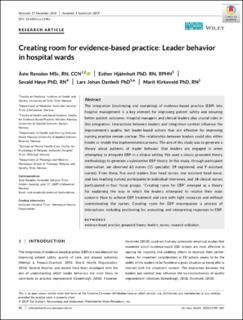Creating room for evidence-based practice: Leader behavior in hospital wards
Peer reviewed, Journal article
Published version

View/
Date
2019Metadata
Show full item recordCollections
Abstract
Abstract The integration (routinizing and sustaining) of evidence-based practice (EBP) into hospital management is a key element for improving patient safety and ensuring better patient outcomes. Hospital managers and clinical leaders play crucial roles in this integration. Interactions between leaders and integration context influence the improvement's quality, but leader-based actions that are effective for improving nursing practice remain unclear. The relationship between leaders could also either hinder or enable this implementation process. The aim of this study was to generate a theory about patterns of leader behavior that leaders are engaged in when attempting to integrate EBP in a clinical setting. We used a classic grounded theory methodology to generate a substantive EBP theory. In this study, through participant observation, we observed 63 nurses (15 specialist, 39 registered, and 9 assistant nurses). From these, five ward leaders (two head nurses, one assistant head nurse, and two teaching nurses) participated in individual interviews, and 18 clinical nurses participated in four focus groups. "Creating room for EBP" emerged as a theory for explaining the way in which the leaders attempted to resolve their main concern: How to achieve EBP treatment and care with tight resources and without overextending the nurses. Creating room for EBP encompasses a process of interactions, including positioning for, executing, and interpreting responses to EBP.
